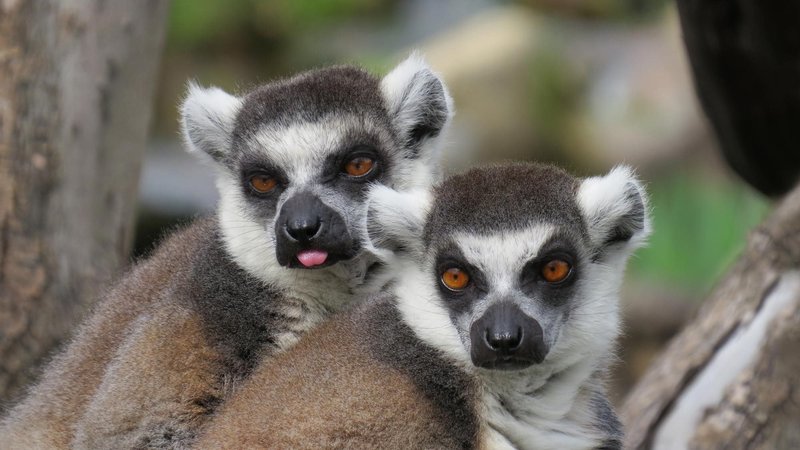
But there’s a lot more to these primates than their cute appearance. They’re full of surprises that highlight their intelligence, social structures, and unique adaptations. So, whether you’re an animal lover or just curious about the wonders of nature, let’s dive into some fascinating facts about ring-tailed lemurs that might just change your perspective on these incredible creatures.
1. Unique Social Structure
Ring-tailed lemurs are known for their strong social bonds. They live in groups called troops, which can range from a few individuals to over twenty. These troops are often led by a dominant female, which is quite unusual in the animal kingdom where males typically take the lead. Imagine a small community where the ladies run the show!
Troops communicate with each other through a variety of vocalizations. They have distinctive calls to alert each other to potential threats, signal excitement, or even just to chat. It’s like having a built-in communication system. Their social interactions help them navigate the complexities of life in the wild, making it easier to find food and protect each other from predators.
The Power of Female Leadership
You might be wondering why female leadership is so significant. In a ring-tailed lemur troop, females not only lead but also have a more stable hierarchy. This structure helps maintain order within the troop and ensures that resources are shared more equitably. It’s a great example of female empowerment in nature, showcasing how collaborative efforts can lead to a smoother existence.
2. Incredible Communication Skills
Aside from their social structures, ring-tailed lemurs are pretty chatty. They use a variety of vocalizations to express emotions and communicate with one another. These calls can sound like loud screams, soft purrs, or even harsh grunts, depending on what they want to convey.
One of their most famous calls is the “alarm call.” This call warns others in the troop of nearby predators. If you were watching from a distance, you might think it sounds like a little monkey going “whoop!” But to them, it’s a crucial signal for survival.
The Language of Scent
Besides sound, lemurs also communicate using scent marking. They have scent glands in their wrists and necks that they use to leave pheromones on trees, signaling their presence to others. Think of it like a message board in the jungle, letting other lemurs know who’s been around and what’s going on in the troop. This dual method of communication helps them maintain social order and avoid conflicts within the group.
3. Striking Stripes and Balance
Ring-tailed lemurs are easily recognized by their striped tails, which are about two-thirds their body length. These beautiful black-and-white stripes aren’t just for show; they also play a role in their social interactions and spatial awareness. The tail acts as a balance aid when they leap from tree to tree.
You might find it fascinating that they can jump distances up to ten feet! Their agile bodies and long tails help them maintain balance as they navigate the forest canopy. It’s almost like watching a skilled gymnast perform breathtaking flips and turns!
The Importance of the Tail
The tail of the ring-tailed lemur also helps them keep in touch with troop members while they’re on the move. When they travel together, they often hold their tails high, creating a striking visual presence that is almost like a flag signaling “follow me!” This way, even in dense foliage, others can easily spot the leader.
4. Omnivorous Diet
Ring-tailed lemurs have a diverse diet. They’re considered omnivores, which means they eat both plants and small animals. Their meals mainly consist of fruits, leaves, flowers, and insects. This varied diet enables them to adapt to different environments and food availability throughout the year.
Madagascar’s climate can be unpredictable, so being flexible in their eating habits helps them survive. If you’ve ever been to a buffet where you can pick whatever you want, you get a sense of how these lemurs enjoy their meals!
They often forage as a group, which strengthens their social bonds and increases their chances of finding food. Watching them rummage through leaves and trees in search of snacks can be quite entertaining. Picture them taking turns, sharing, and deciding as a team where to go next. Isn’t that teamwork at its finest?
5. Endangered Status
Despite their charm, ring-tailed lemurs are currently classified as endangered. Habitat loss, mainly due to deforestation and human encroachment, poses a significant threat to their survival. As Madagascar’s forests are cut down for agriculture and development, these adorable primates lose their homes.
You might be asking, “What can be done to help?” Well, many conservation efforts are underway to protect their natural habitat and raise awareness about their plight. Organizations are working to create protected areas and educate local communities about the importance of preserving these unique creatures and their environment.
Community Involvement
Supporting local communities can play a huge role in conservation. When people have sustainable alternatives to deforestation, it reduces pressure on lemur habitats. Just think—by helping local farmers learn how to cultivate crops without destroying forests, we can contribute to saving these incredible creatures!
6. Unique Grooming Habits
Grooming is an essential part of life for ring-tailed lemurs. They spend a significant amount of time taking care of each other’s fur, which is more than just about cleanliness. This habit fosters social bonds and reduces tension within the troop, almost like a calming spa day!
During grooming sessions, you might notice that they use their teeth to clean each other’s fur carefully. It’s a bonding experience, and you can see them relaxing and enjoying each other’s company. It’s kind of like a cozy catch-up with a friend over coffee!
Health Benefits
Additionally, grooming plays a crucial role in the *health* of the lemurs. Regular cleaning helps to remove parasites and dirt, keeping their coats fresh and healthy. So, while it might seem like a social pastime, it’s also an important survival strategy.
7. Matriarchal Groups
As mentioned earlier, ring-tailed lemurs have a matriarchal society. In these groups, females hold most of the power, particularly when it comes to decision-making. The dominant females lead the troop and dictate movement, foraging, and social interactions. It’s a refreshing change from the typical patriarchal structures seen in many animal species.
This leadership style not only empowers females but also creates a more cohesive troop dynamic. The females often work together to teach younger lemurs essential survival skills, ensuring that their knowledge is passed down through generations. It’s a community effort to raise the next generation of ring-tailed lemurs.
Leadership Dynamics
Interestingly, the position of the dominant female can change over time. As older females pass away or new members join the troop, leadership can shift, keeping the social structure dynamic and adaptable. Watching these changes provides insight into how flexible and responsive animal societies can be.
8. Interesting Breeding Behavior
When it comes to mating, ring-tailed lemurs have a rather unique approach. They have a short breeding season, typically in the spring, which coincides with the warmer months in Madagascar. During this time, females go into estrus and emit special scents to attract males.
Males engage in a ritual called “stink fights” to compete for female attention. They rub their scent glands on their tails and wave them in the air, creating a pungent smell that’s meant to impress females and deter rivals. You could say it’s their way of showing off!
Family Dynamics
After mating, females give birth to one or two babies, usually in late summer. These infants are born in a vulnerable state and rely heavily on their mothers for care. The entire troop plays a role in nurturing the young lemurs, which ensures that the next generation receives ample support. It’s heartwarming to see how a community can come together to raise its young.
9. Playful Nature
One of the most delightful aspects of ring-tailed lemurs is their playful behavior. They love to engage in play, especially as youngsters. You might spot them climbing, tumbling, and chasing each other around. This playful activity isn’t just for fun; it’s a vital part of their development. Play helps them build social skills, improve coordination, and learn important survival techniques.
Imagine watching a group of kids at a playground, laughing and running around—that’s the same vibe you get when observing young lemurs at play! They seem to have an endless supply of energy, which makes them utterly captivating to watch.
Learning Through Play
Through this playful behavior, young lemurs learn how to navigate their complex social structures and develop the skills they’ll need as adults. The playful moments can be a joy for both lemurs and spectators alike, showcasing their vibrant personalities and social natures.
10. Cultural Significance
In Madagascar, ring-tailed lemurs hold a significant place in local culture and folklore. They are not just another animal; they are symbols of Madagascar’s unique biodiversity. Many local communities have myths and stories that revolve around lemurs, emphasizing their importance in the ecosystem.
Conservationists often use these cultural connections to promote awareness and conservation efforts. By emphasizing the cultural significance of the ring-tailed lemur, they help local communities see the value in protecting these animals and their habitats.
Education and Awareness
Through education programs and conservation campaigns, people are encouraged to learn more about these creatures and the challenges they face. By fostering a sense of pride in their unique wildlife, Madagascar can work toward a brighter future for its ring-tailed lemurs.
In conclusion, ring-tailed lemurs are not just adorable creatures; they’re fascinating animals with complex social structures, unique adaptations, and an essential role in the environment. Understanding these facts not only deepens our appreciation for them but also highlights the importance of protecting them. So next time you see a cute lemur picture, remember all the incredible traits and the challenges they face—and maybe, just maybe, you’ll be inspired to help make a difference.

